

- 54. 10 Useful Pieces of Advice for Teaching with LEARNING WORLD #9 & 10
- 55. “Happy New Year!” “I don’t say that.”
- 53. Halloween 2019
- 52. READY Workbook Pg. 17
- 51. English-Uplift 1-Day Seminars
- 50. READY Workbook - vocabulary copying activity
- 49. 10 Useful Pieces of Advice for Teaching with LEARNING WORLD #8
- 48. 10 Useful Pieces of Advice for Teaching with LEARNING WORLD #7
- 47. 10 Useful Pieces of Advice for Teaching with LEARNING WORLD #6
- 46. 10 Useful Pieces of Advice for Teaching with LEARNING WORLD #5
- 45. 10 Useful Pieces of Advice for Teaching with LEARNING WORLD #4
- 44. 10 Useful Pieces of Advice for Teaching with LEARNING WORLD #3
- Kindergarten aged students
- Lower Elementary-school aged students
- Upper Elementary-school aged students
- Junior High and older students
- Others
15. Yesterday’s seminar
A Bridge to the Future!
Who else made themselves available to attend the Tokyo English Education Innovation Seminar yesterday? Wasn’t it fantastic?!!
Nakamoto-sensei’s presented the first glimpses inside two important new APRICOT releases due out in the Spring of next year: “Learning World Bk.4: BRIDGE” and “Learning World Bk.6: the FUTURE”.
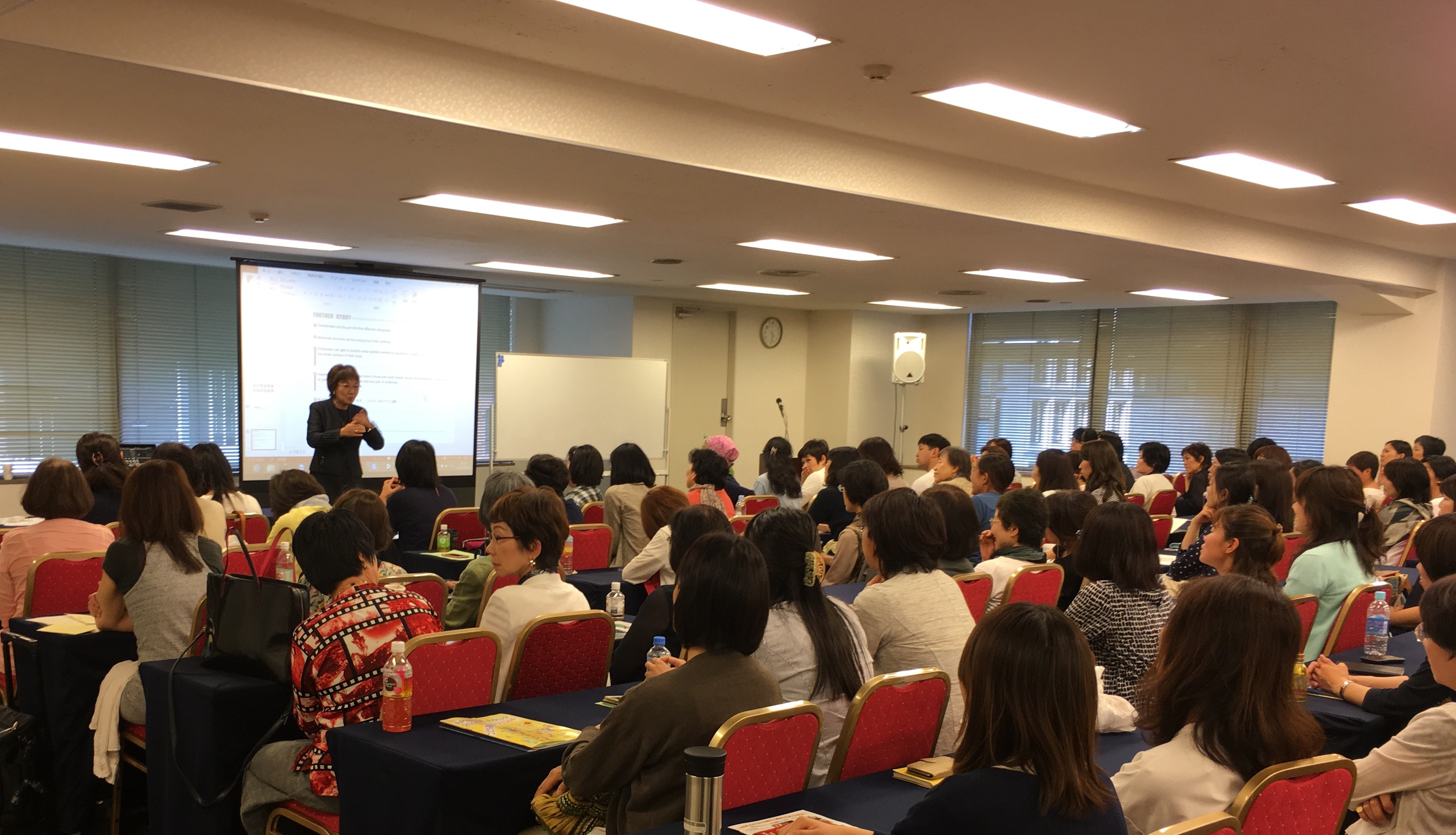
“BRIDGE” will replace the current “CHANTS for Grammar” publication and become an official part of the Learning World Series.
“The FUTURE” will become the final book of the series, after a revised (and renamed) “Learning World Bk 5: Tomorrow”.
The new additions to the Learning World line-up will complete a 10-year Learning World curriculum that has I believe the potential to completely shake up and wake up the education of English in this country.
Again Nakamoto-sensei has demonstrated a profound insight to the very real needs of Japanese youth and their unproductive relationship with the English language and study of it.
She has met these needs with astounding creativity. The examples and text excerpts shown at yesterday’s presentation were more than enough to have those of us in attendance feel that our students were in for some really exciting times ahead…! It was the kind of material that you couldn’t wait to get your hands on. It was the kind of material that you could imagine your students getting thoroughly involved in. It was the kind of material that you wished APRICOT would miraculously make available for ALL of us TODAY, RIGHT NOW because our classes TOTALLY need it NEXT WEEK!!!
One new and very exciting feature of “The FUTURE” is the DVD. A total of 20 short videos are in the pipeline, and lessons are planned around them. The example video shown was very professionally put together – a mini-documentary with genuine authenticity but with easy application in the classroom too. It was not surprising to learn that Kawahara-sensei was behind its production because only she is able to manage that kind of balance.
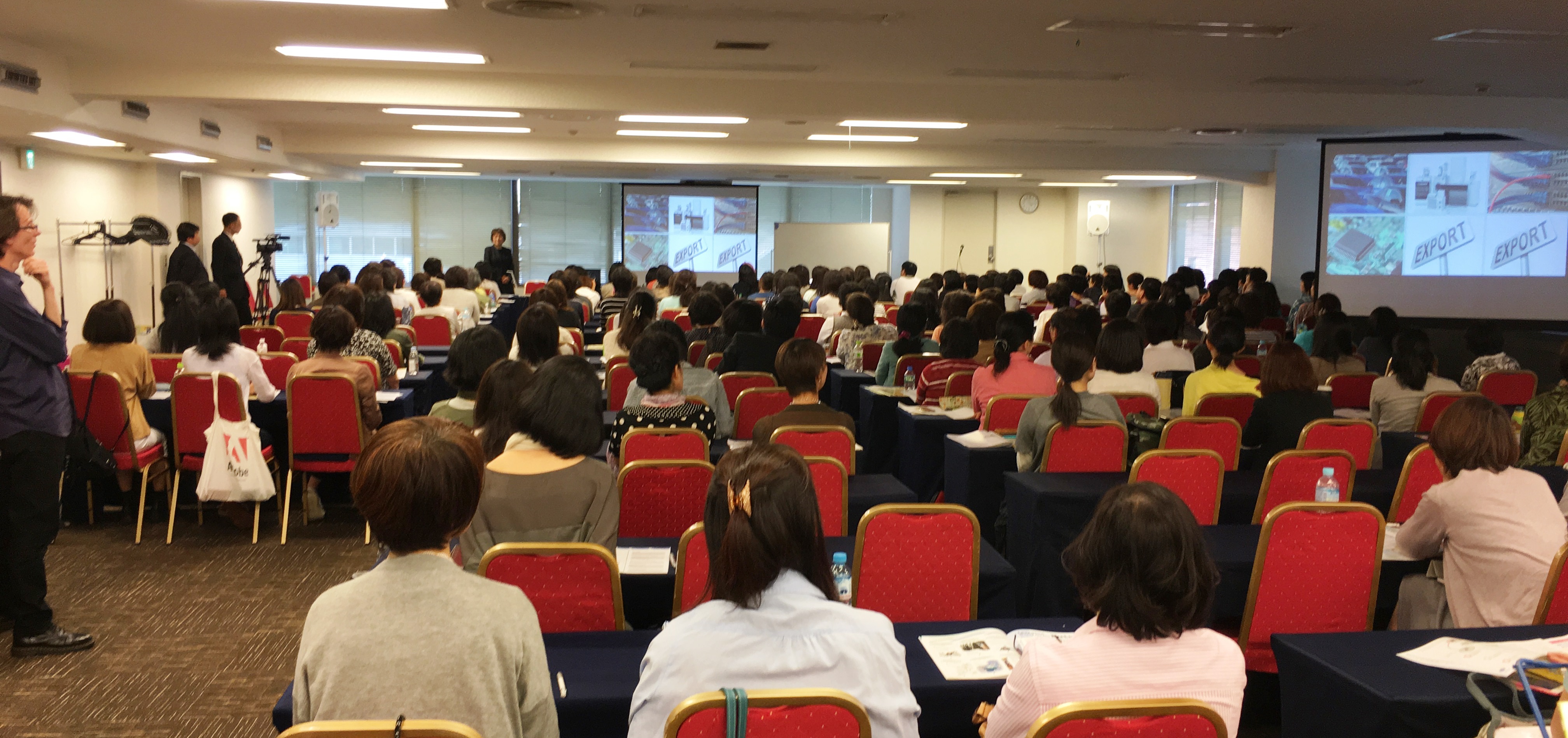
Look, if you weren’t able to get along to the Seminar yesterday, there will be more opportunities to attend in the coming weeks as it makes its way around the country.
Please get to one! You’ll be really surprised, really inspired, and really wish next year was now!
14. How to use a worksheet one line…
The new year has well and truly started. I imagine we are all back teaching at page 1 of each of Learning World’s textbooks, right? I hope the Learning World Workshops in March proved valuable to you as you and your students begin the new year!
Here is a very uninteresting-looking worksheet that I created just before the Spring break. It was designed for students on LW Book 3.
Although uninteresting-looking, this worksheet in fact became quite effective for:
- inputting new vocabulary related to adjectives (hot → the hottest, small → the smallest, beautiful → the most beautiful etc.)
- having students create their own sentences based on this vocabulary.
As the worksheet doesn’t appear to make much sense, it’s better to present it to students revealing one line at a time. Use construction paper. Present the top line first:
Encourage students to generate possible answers.
My students initially suggested “Christmas”.
After I reminded them that there are 12 months in the year, they suggested “last”.
Have students write “last”.
Have students color “December”, “last”, “month” and “year” using 4 different colors.
My students chose orange, blue, green and yellow:
Have students reveal the next line:
Have students color this word.
After some discussion, my students agreed that if “last” was blue, then “first” was probably blue too.
Have students read aloud “December is the last month of the year”. Students will soon produce “January is the first month of the year”.
Have them write it:
Have students color this English too.
Have students to reveal the next line:
There is understandable confusion when “c______” is revealed.
Hint to your students that this word is blue.
My students immediately guessed “cold”, and straight away wrote “February is the cold month of the year”.
With the students themselves suggesting “February”, inputting the concept of “coldest” becomes simple.
Now it’s time to apply this concept to other adjectives…
Have students reveal the next line:
“February is the coldest month of the year”, so your students will have understandable confusion about what to do with the word “mountain”.
Ask your students to color it.
A little thought and discussion among themselves will have them agree that the word “mountain” is not comfortable at the start of the sentence, so cannot be orange; nor is it good at the end, so cannot be yellow; nor is it an adjective, so cannot be blue. It can really only be green.
With “mountain” green, your students will soon suggest ”Mt. Fuji” as orange. With “Mt. Fuji” orange, they will soon suggest “Japan” as yellow. Now they need an adjective for blue English. Input “high” if needed, and have students apply “highest”.
Once this English is colored, students can reveal the next line:
With the words “mountain” and “the world” revealed, your students will soon produce “Mt. Everest is the highest mountain in the world”.
The next line reveals the word “river”.
Now, before this point, each answer was largely decided. From here students can exercise more freedom of expression.
My students chose “The Amazon River” as orange English, and as a result the blue English became “longest” and the yellow English became “the world”. However if the students choose “Japan” as the yellow English, then the orange English becomes “Shinanogawa”. Alternatively, a change to the blue English will create different orange and yellow English. Perhaps a quiz with your students can become a good reason to input new adjectives:
“Ayasegawa (Tokyo) is the _______________ river in Japan” (dirtiest)
“Amedakegawa (Hokkaido) is the ____________ river in Japan” (cleanest/ most beautiful)
[⇒Source: http://matome.naver.jp/odai/2134598023082342201]
“Tazawako is the ___________ lake in Japan” (deepest)
[⇒Source: http://www.tabi2ikitai.com/geography/j0102a/a01006.html]
For homework, I gave the following worksheet to my students:
You can imagine how disappointed they were to discover that they weren’t able to choose any of the colored English for #3!! They quickly learned however that the word “not” goes very nicely after the word “is”!
13. Thank you for coming to the Learning World WORKSHOPS!
It was really, really good seeing so many teachers at the recent Learning World Workshops in Osaka, Nagoya and Tokyo.
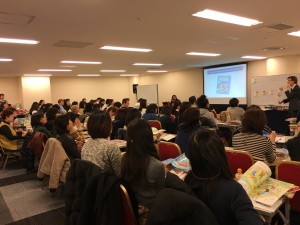 Osaka 2/28
Osaka 2/28
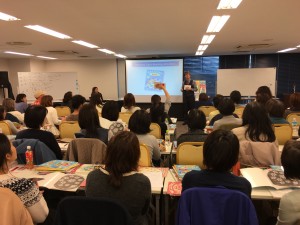 Nagoya 3/6
Nagoya 3/6
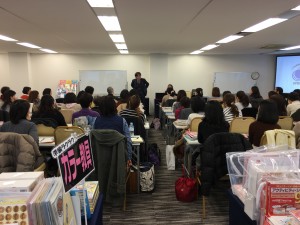 Tokyo 3/13
Tokyo 3/13
As a presenter, it’s exciting to see new faces. I always hope that new teachers can relate to the issues we bring to our Workshops, and can take home perhaps a new angle of looking at their teaching. If it was your first time to attend an APRICOT Workshop, I say thank you for coming, I hope you found it worthwhile, and I hope to see you again!
And as a presenter it’s of course also encouraging to see familiar faces. It tells me that teachers are indeed finding value at our Workshops, and are returning for more. If it was not your first time to attend an APRICOT Workshop, I say thank you for coming again, I hope you’re not tired of me presenting, and I definitely hope to see you again!
Thank you especially if your attendance at one of the Workshops involved a lot of travel. I understand that more than twenty teachers used the bullet train, and a few even arrived by plane! Your commitment of time and money to study reflects your commitment to your students. I think your students should give YOU a sticker!!
This year’s topic was a tough one – but a very important one, and one that has really been in want of discussion. The process of having our students attain the skill of reading can be frustrating for both teachers and students. However, if the teacher has a sound educational policy in place, if the students’ learning environment is stable, and if certain objectives are set and met with appropriate materials, students can find significant success with reading in a reasonable amount of time. My presentation at the Workshops attempted to show this.
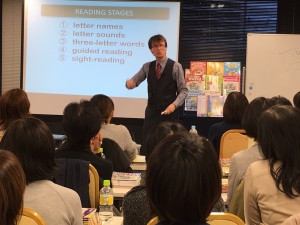
Thank you for your patience with the venue’s cramped conditions.
Thank you for your patience with occasional technical difficulties.
Thank you for your patience with my battle to stay properly time-managed!
Thank you for your written feedback. It means a lot to me, and APRICOT too of course. It lets us know that if we are making a positive difference for you and your students or not. Essentially, that’s what we want the Workshops to do. That’s what the Workshops need to do. Please know that the Learning World Workshops are YOUR workshops. Not one single Workshop will always satisfy everybody’s needs, as everybody’s teaching situations can differ widely. But your input in the form of inquiries to APRICOT is useful and welcome! Your inquiries help APRICOT understand where your concerns are, and these form the basis for Workshops.
If you weren’t able to join this year’s Learning World Workshops, please join us next year! Whether I’m presenting again or not next year, I hope to see everybody there!!
Thank you again!
12. NICE CREATIVE WRITING!
Can I share with you this piece of writing by one of my students?
She is in junior high 2nd grade, and has been studying with me for 50 minutes a week since she was in 1st grade elementary school. Her first textbook was WELCOME to Learning World Blue. She has since completed every textbook in the LEARNING WORLD Series.
Soon after the winter break I gave her a writing assignment for homework. This is what she produced:
↓
2015: 5/10
I am not very satisfied with 2015 because I was injured many times. So I couldn’t practice basketball a lot.
Furthermore I couldn’t study a lot. So I wasn’t satisfied my test score.
However, I worked hard school committee activities. I proud myself about it.
My goal for 2016 is to laugh a lot than last year because this year will be more busy than last year. So I think I have to laugh a lot to enjoy this year.
Furthermore, I willn’t the absolute injury this year!
Yes, it’s clear that her writing is not free of language errors. But to be honest I was quite happy with it, and surprised at its quality.
The writing of a reflection on 2015 and goals for this year, together with the vocabulary “satisfied”, “furthermore” and “however” was my idea, but everything else was hers.
■Step 1: I input the meaning of “satisfied” together with the idea of a score:
“I am totally satisfied“ → 10/10
“I am very satisfied“ → 9/10
“I am satisfied“ → 7/10
“I am not very satisfied“ → 5/10
“I am not satisfied“ → 4/10
“I am not satisfied at all“ → 2/10
■Step 2: On a piece of paper I asked her to write “2015:” and then give it a score.
■Step 3: I gave her the following dictation:
“I am not very satisfied with 2015 because………….
Furthermore…….
However….
My goal for 2016 is…….
Furthermore……”
■Step 4: On completion of the dictation I explained that “furthermore” means “and”. And I explained that “however” means “but”.
■Step 5: I asked her to complete it for homework.
The combination of her junior high grammar knowledge with the structure provided by me helped put her ideas onto paper. By all means, please use this idea as an end-of-year activity, or even an end-of-term activity.
Creative writing is definitely facilitated by experience in reading. These two areas of English education will be dealt with in depth at this year’s LEARNING WORLD Workshops, scheduled for Feb.28th (Osaka), Mar.6th (Nagoya) and Mar.13th (Tokyo).
I really hope to see you there!
★★Learning World WORKSHOP INFORMATION⇒⇒Click here!
11. “AJ Picture Dictionary: A little creative speaking and writing.”
Did you have a relaxing New Year? I hope so!
With “How was your Winter Vacation?” lessons well and truly finished, our heads and our students’ heads are back into their textbooks…
As you know, I’m always keen to provide creative expression opportunities for students. AJ Picture Dictionary helps a lot with both creative speaking and creative writing.
Scene 18 “A School Play” is an interesting page, with musical instrument names and hairstyles commanding probably most of students’ focus.
In a class of middle to upper elementary school students….
1.Ss open their books to Scene 18.
After some general discussion on the contents of the page, I ask some specific questions (based on the grammar at the bottom of the page):
T: “Who’s that boy playing the tambourine?” Ss: “[That’s] AJ.”
T: “Who’s that girl playing ‘Tripitaka’?” Ss: “I don’t know…. Oh, that’s Cindy.”
T: “Who’s that woman holding the camera?” Ss: “That’s Bob’s mother.”
T: “Who’s that boy playing the Monkey?” Ss: “I don’t know…. Oh, that’s Jack.” (Bright Ss will find the answer at the bottom of the page!)
T: “What’s his name?” Ss: “I don’t know… Oh, that’s Jim.” (Again, bright Ss will find the answer at the bottom of the page!)
Then:
T: “Who’s the boy playing the guitar?” Ss: “I don’t know…”
T: “That’s Masato!”
Using students’ names in the same context will generate the English “I can’t play [the guitar]” etc.
2. Using cut-up photocopied pictures of each orchestra player, Ss create “four groups” of pictures.
Students’ groupings are interesting: [very big/big/small/very small], [black/brown/gold/others] etc. Musically experienced students may group the instruments according to their classification: [brass/woodwind/percussion/string], though they very rarely know this English specifically. (Incidentally, the piano is outside classification as it’s neither a string instrument nor a percussion instrument. The synthesizer is classed as an Electronic instrument).
3. Ss are given a white B4 sheet of paper and are instructed to fold it into eight boxes.
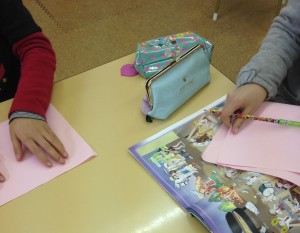
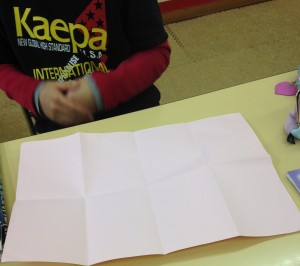
4. Ss are given strips of paper with English.
Each strip is given one at a time!
Each strip is glued into a box on the B4 paper, and Ss draw its picture.
Strip #1: “a girl playing a trumpet”
Strip #2: “a boy playing __ ___________” (Ss write an instrument of their choice).
Strip #3. “a ______ playing ___ ________”
Strip #4: “a ______ _____ ___ _________”
Students are allowed more creative freedom with each strip of paper. The drawing of each picture takes time. The very first picture “a girl playing a trumpet” is completed in class. Depending on time, other pictures can be done for homework.
Next, Strip #5: “a girl with a braid”
Students initially look for an instrument called “a braid”(!) Eventually this English is noticed amongst the hairstyles of the audience.
Strip #6: “a man with a _________”
Strip #7: “a woman with ________________”
Strip #8: “a _____ with _________________”
Once completed, the B4 paper looks like this:
I love AJ Picture Dictionary. Again and again, it offers students important creative writing experiences. Hopefully you can bring these experiences to your classroom too!











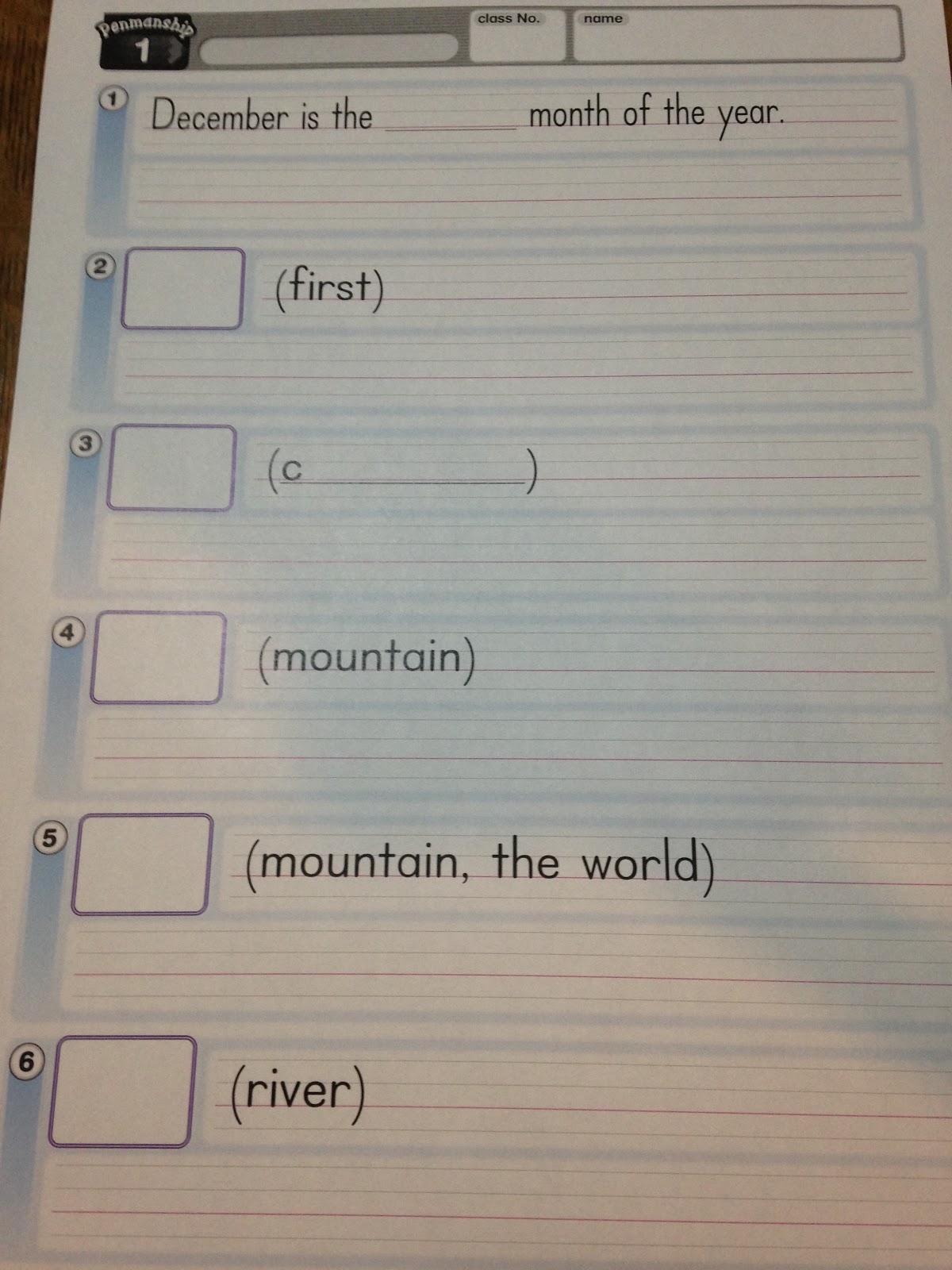
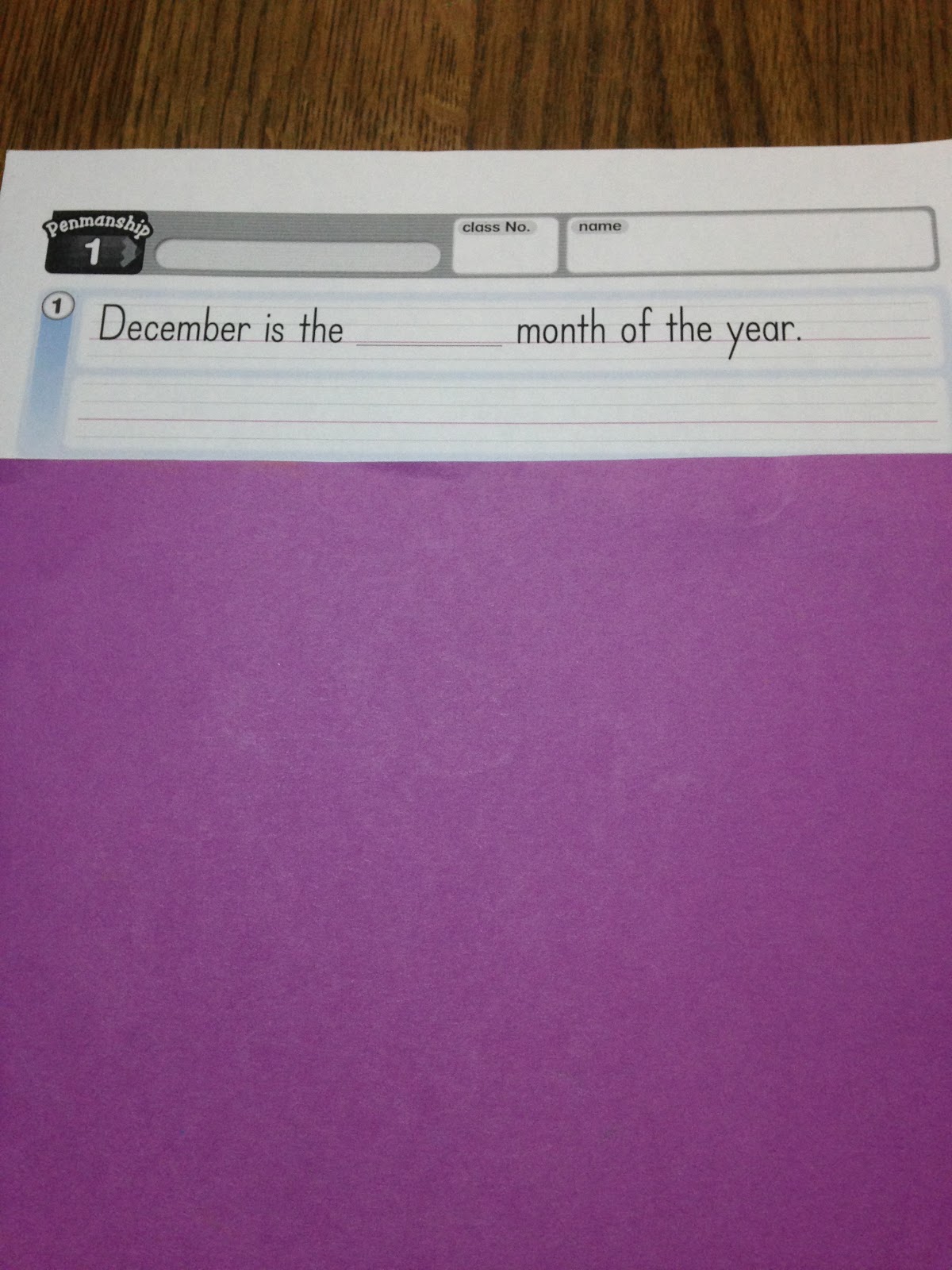
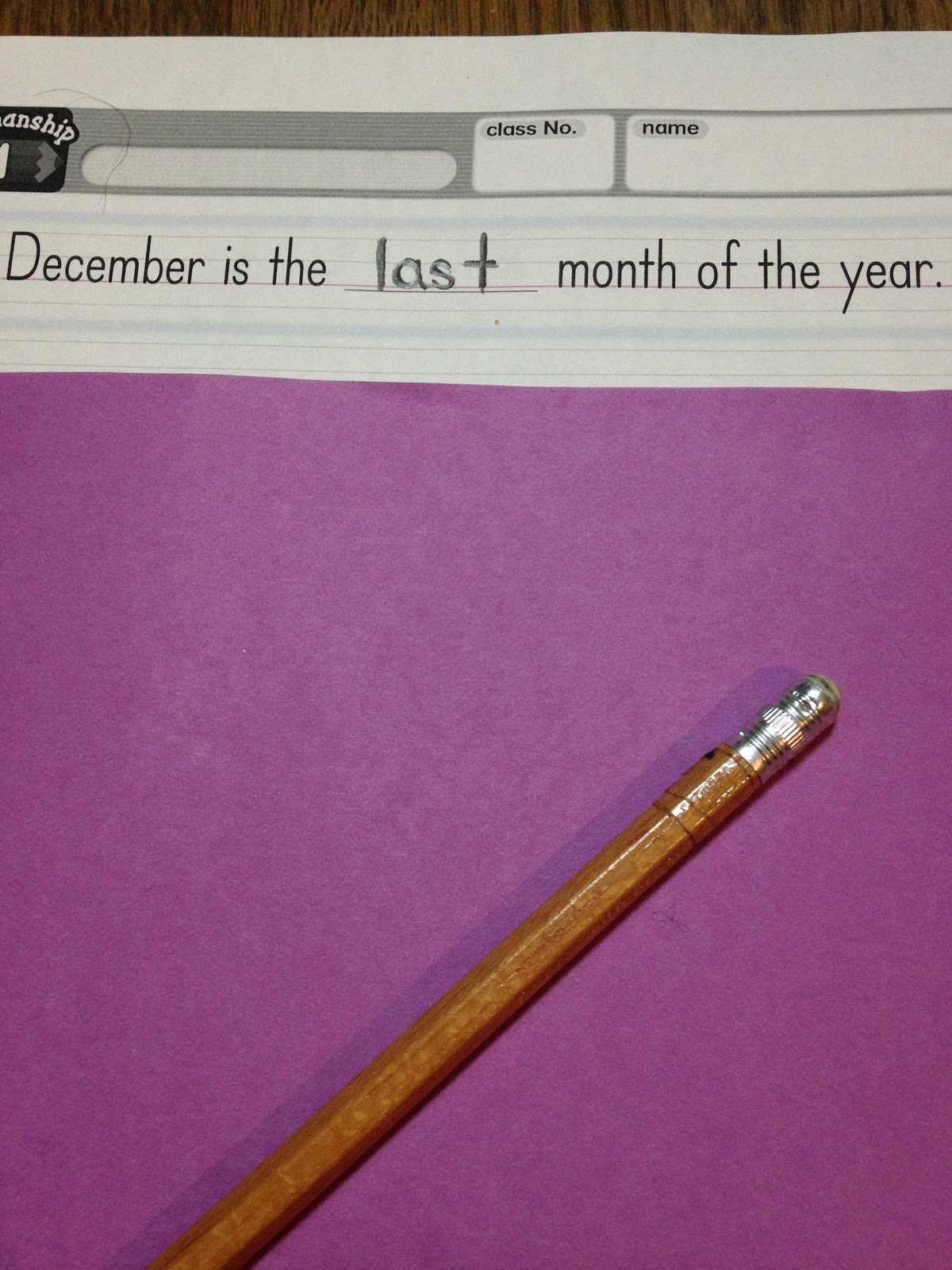
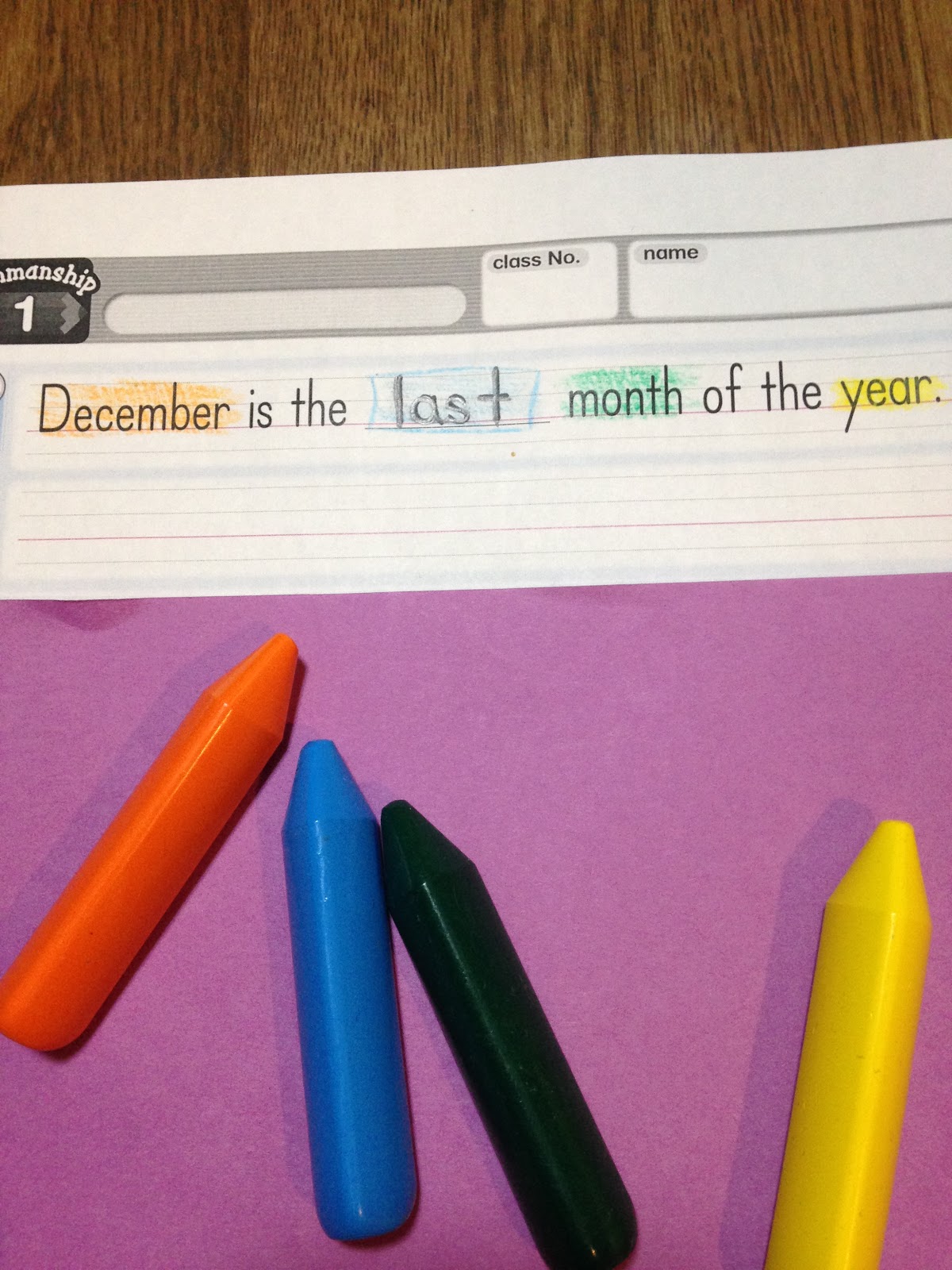
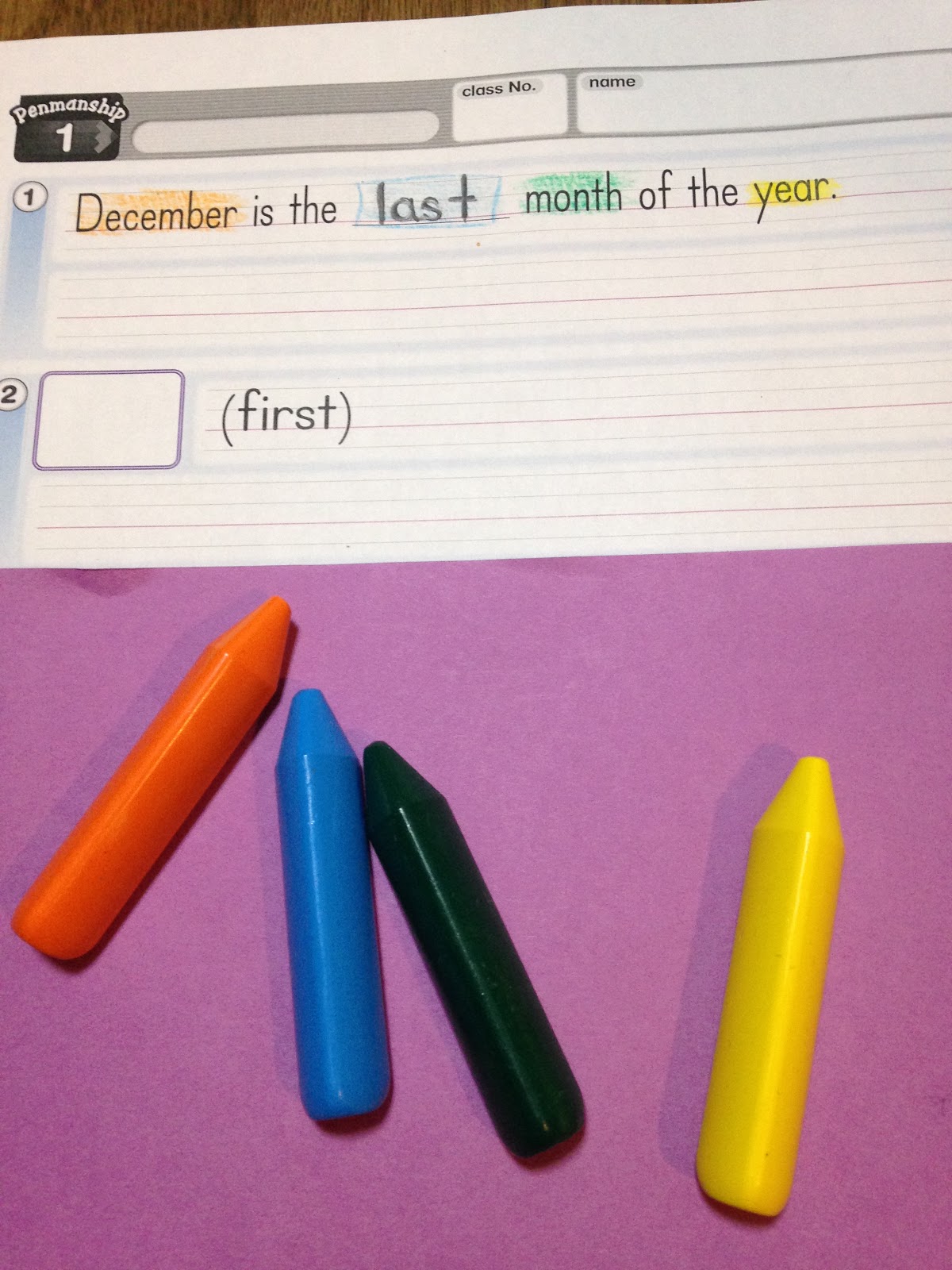
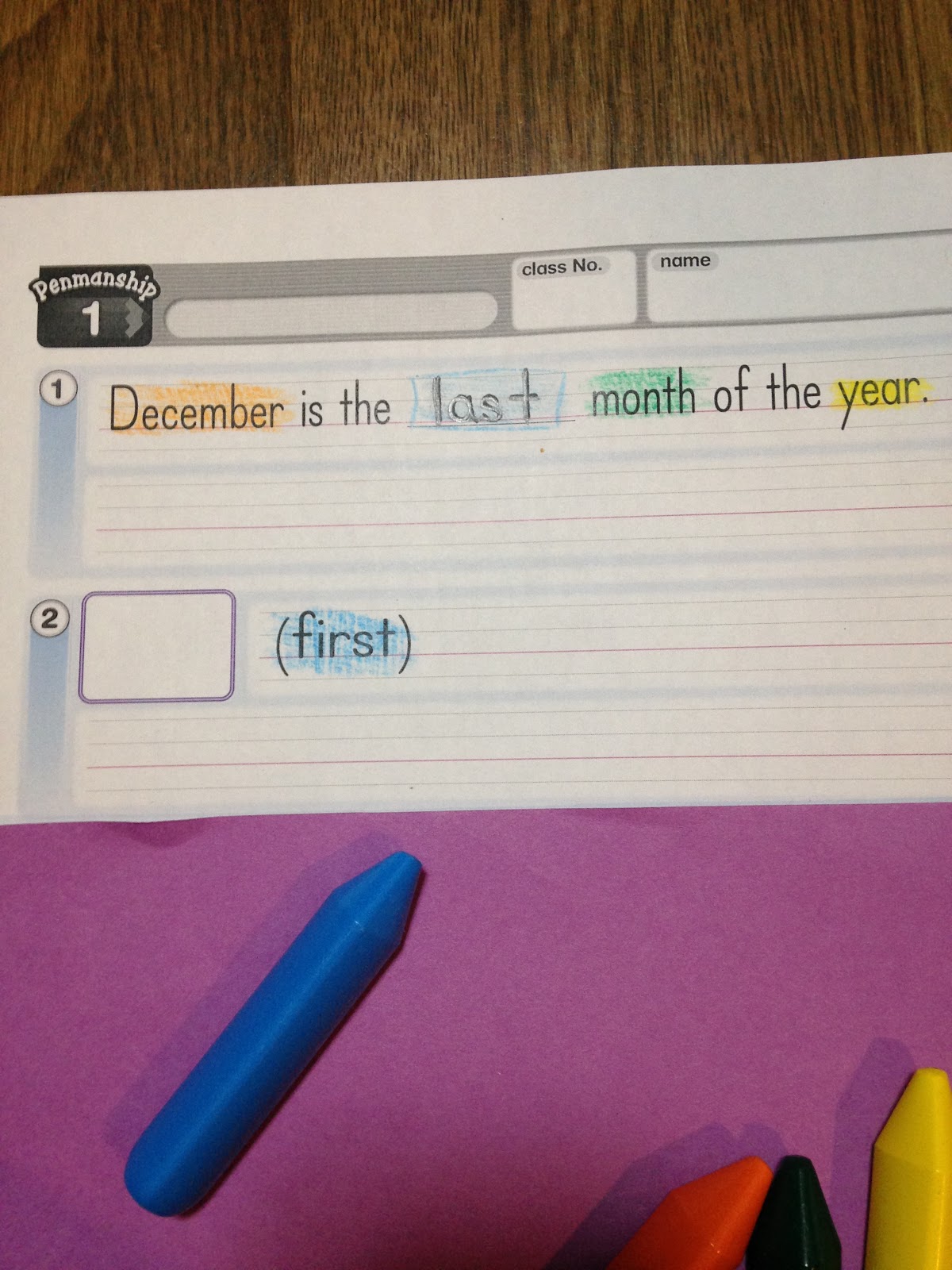
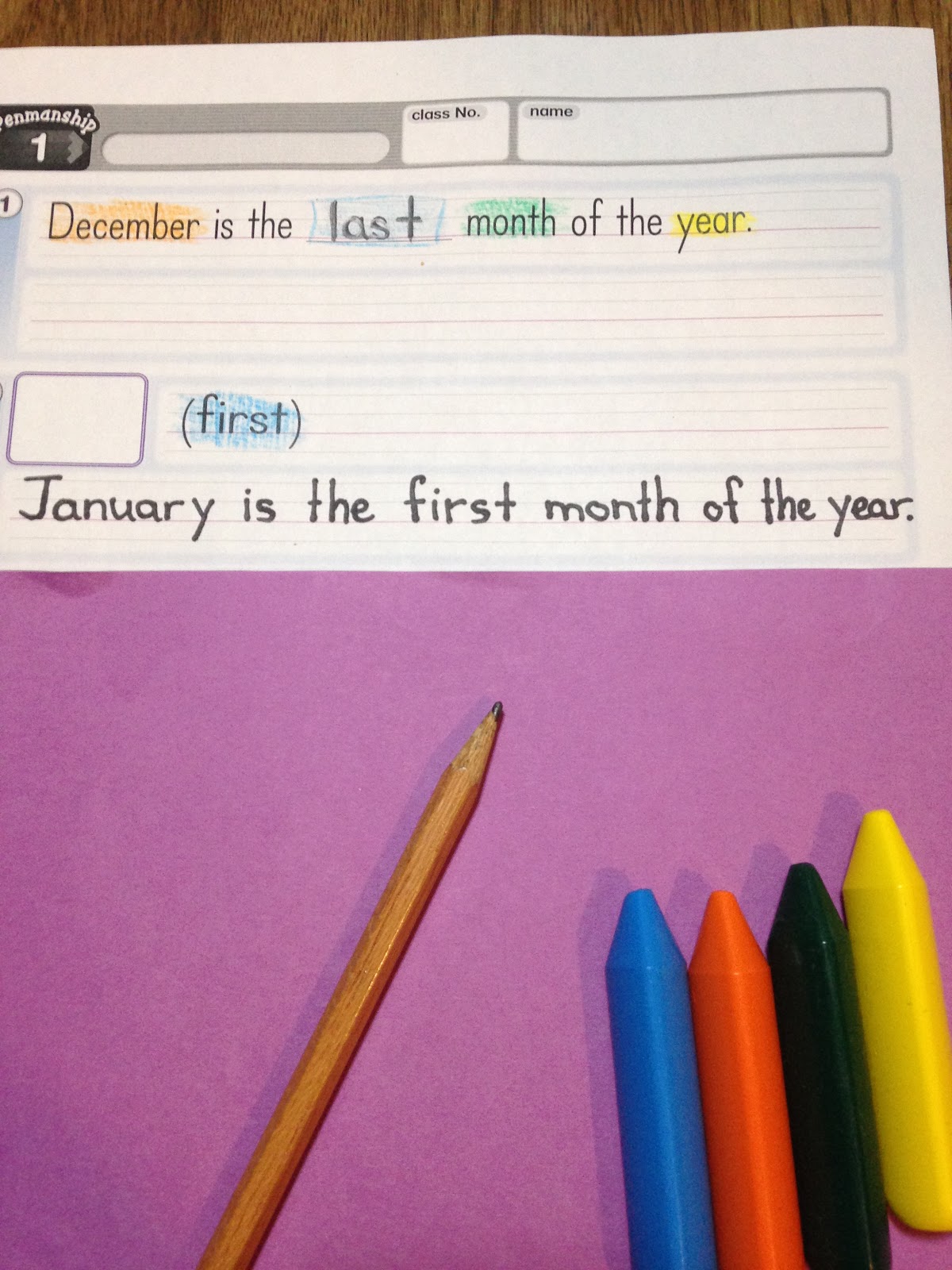
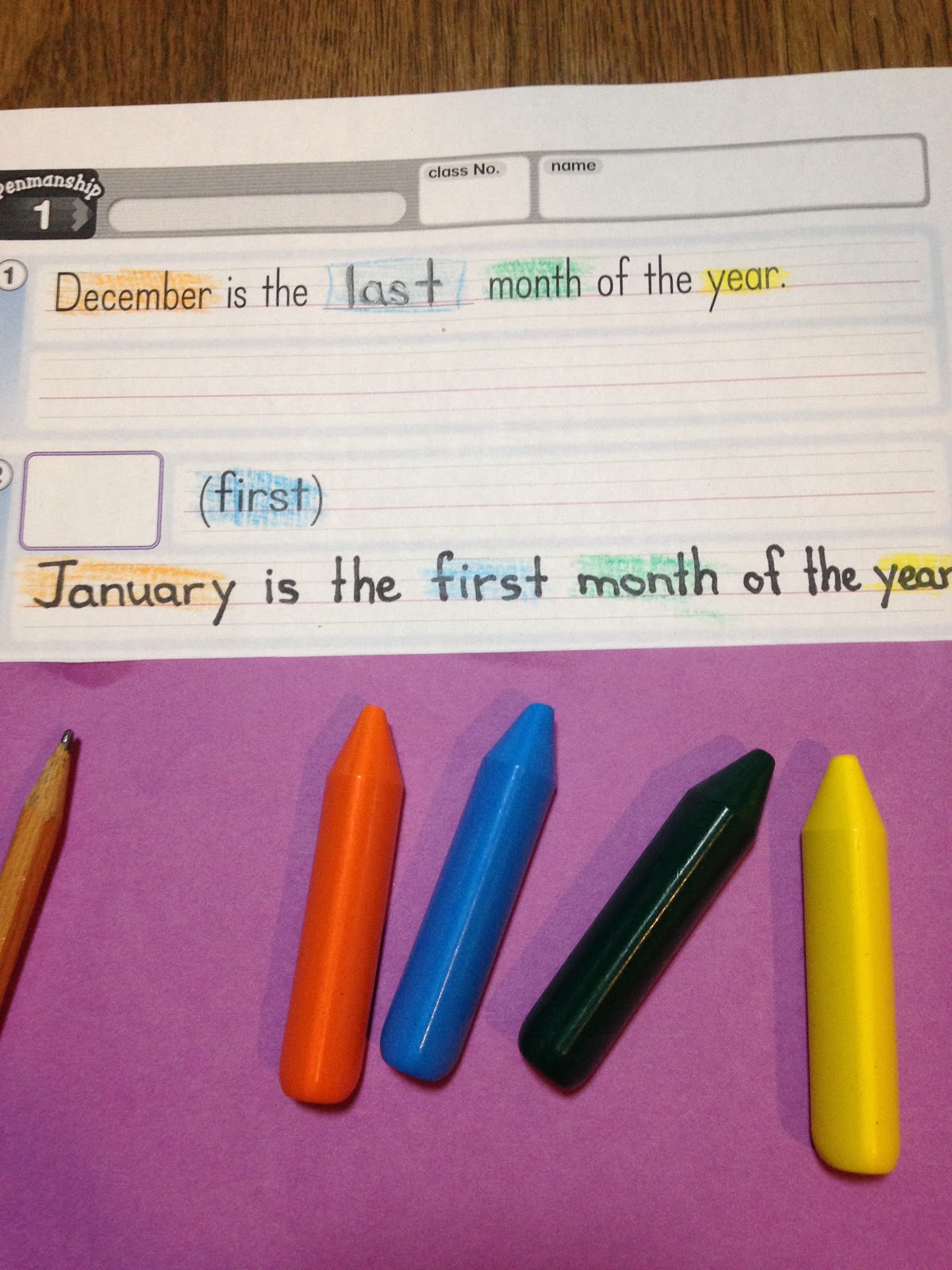
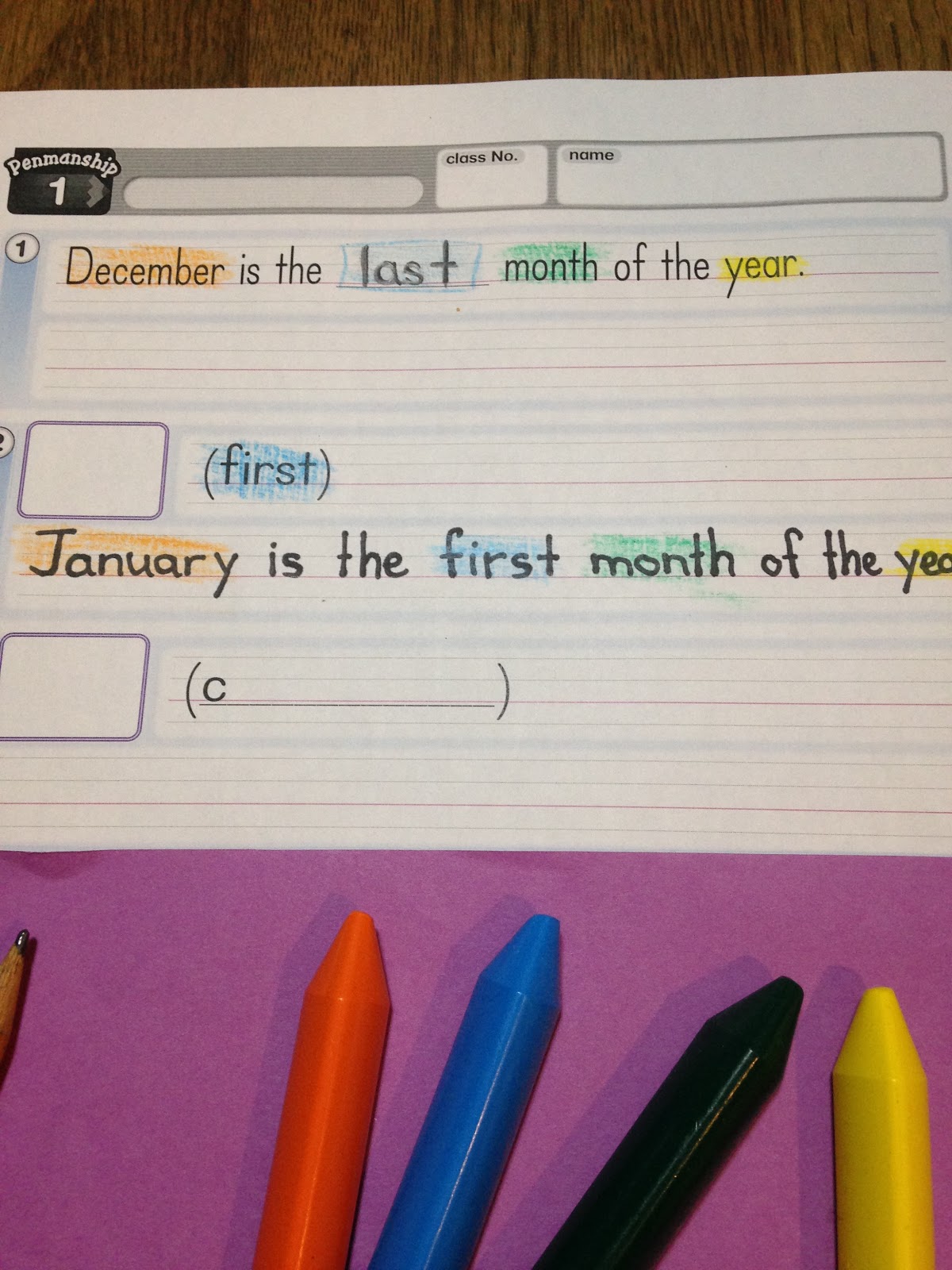
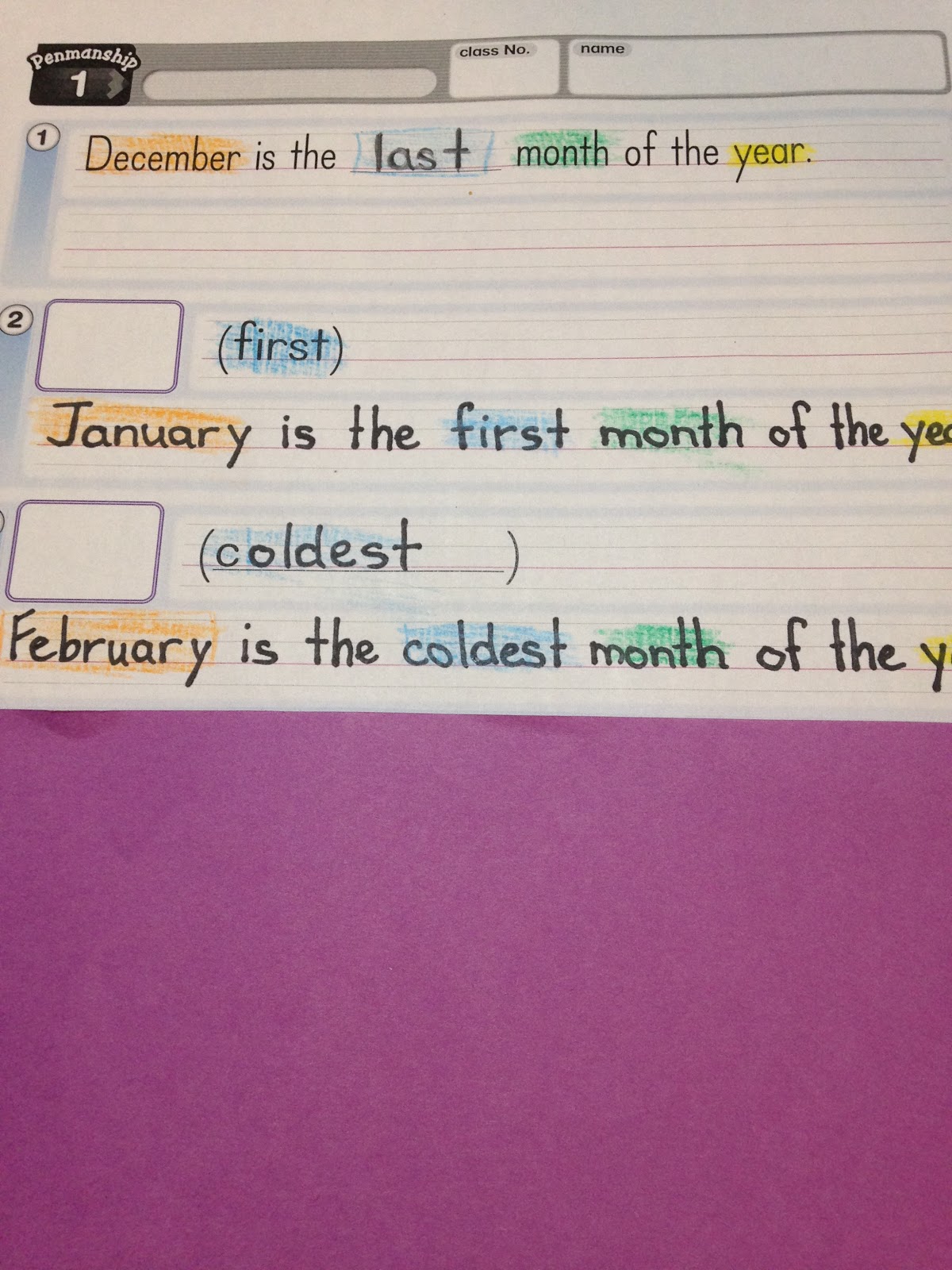
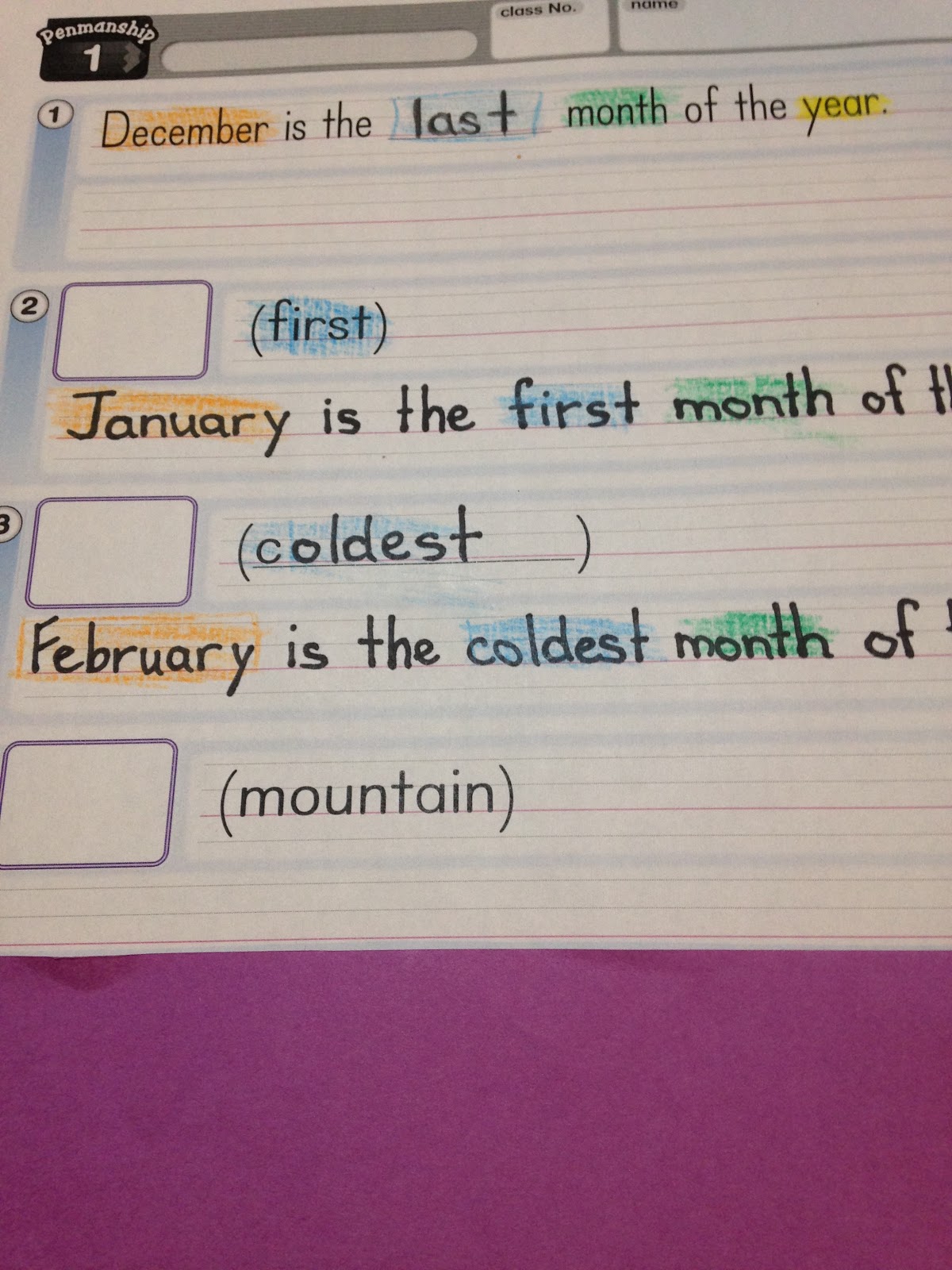
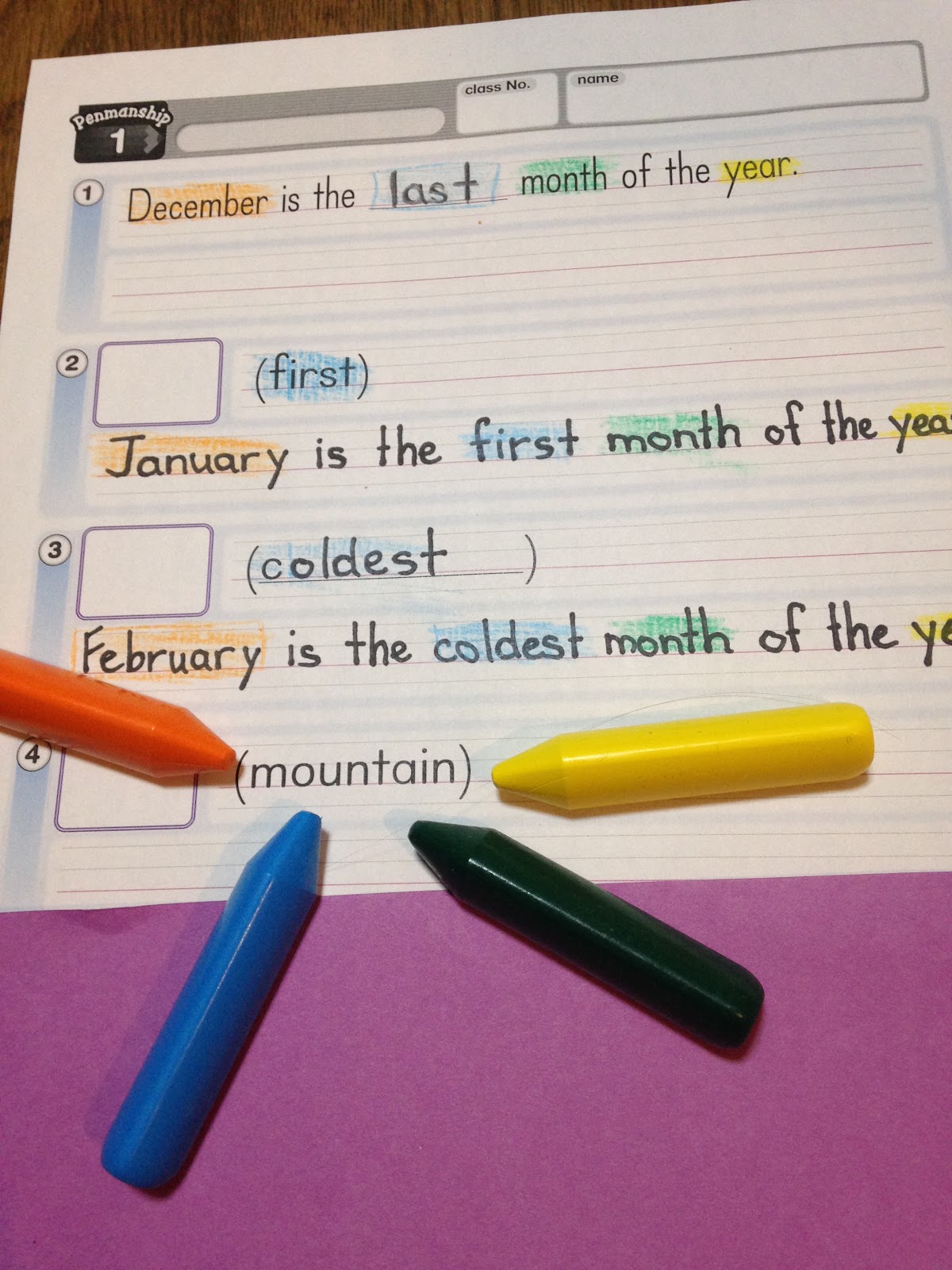
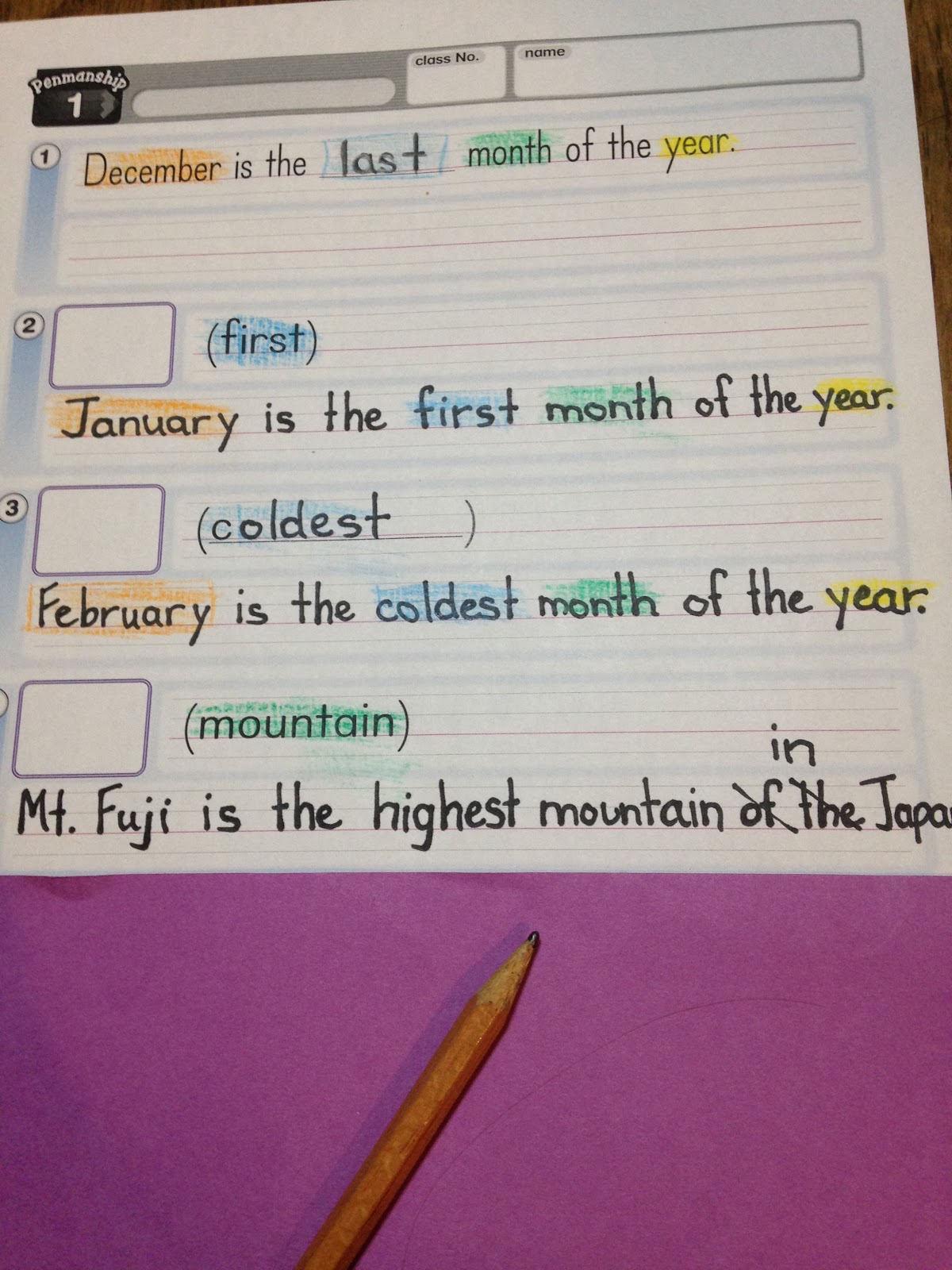
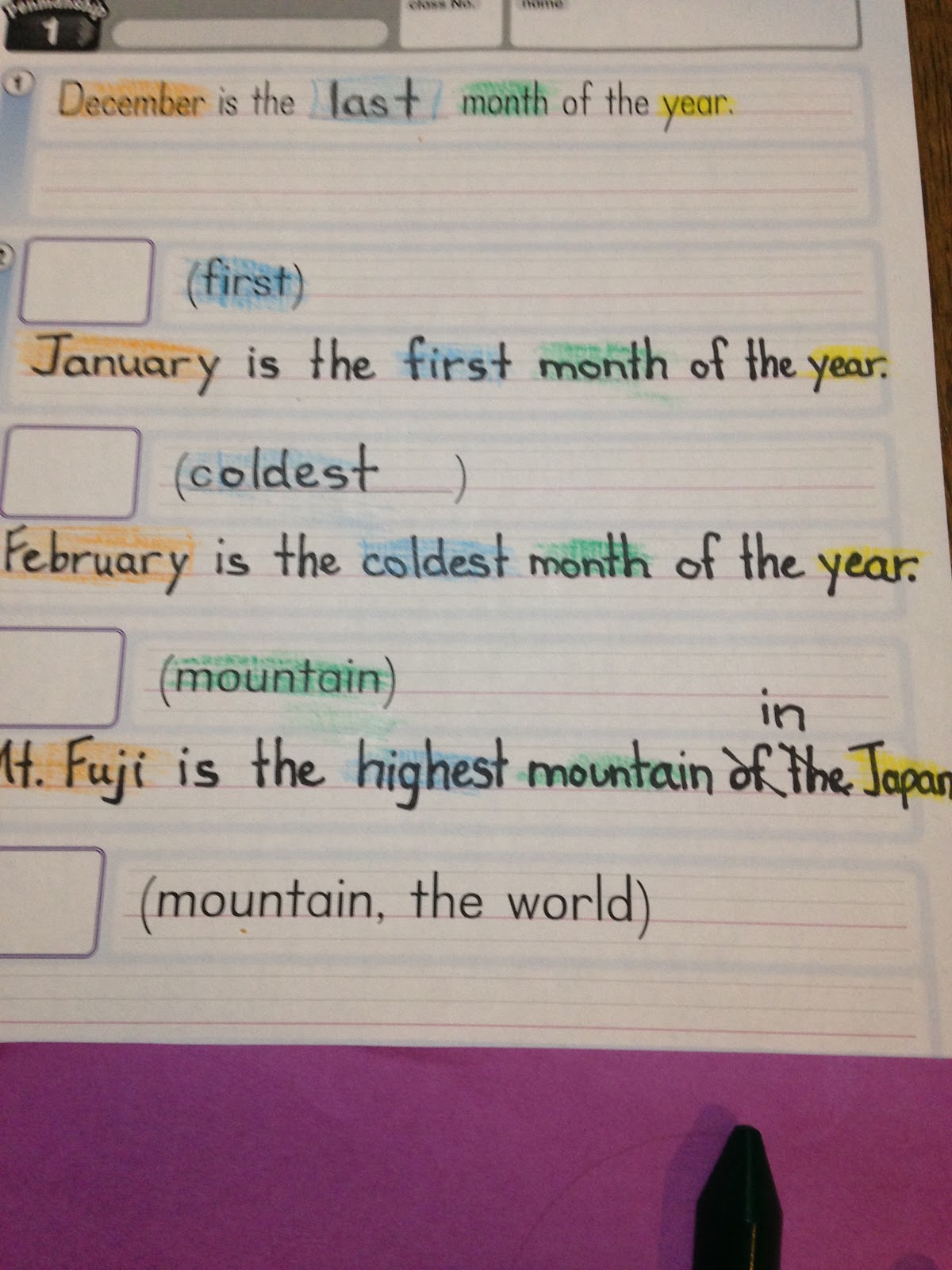
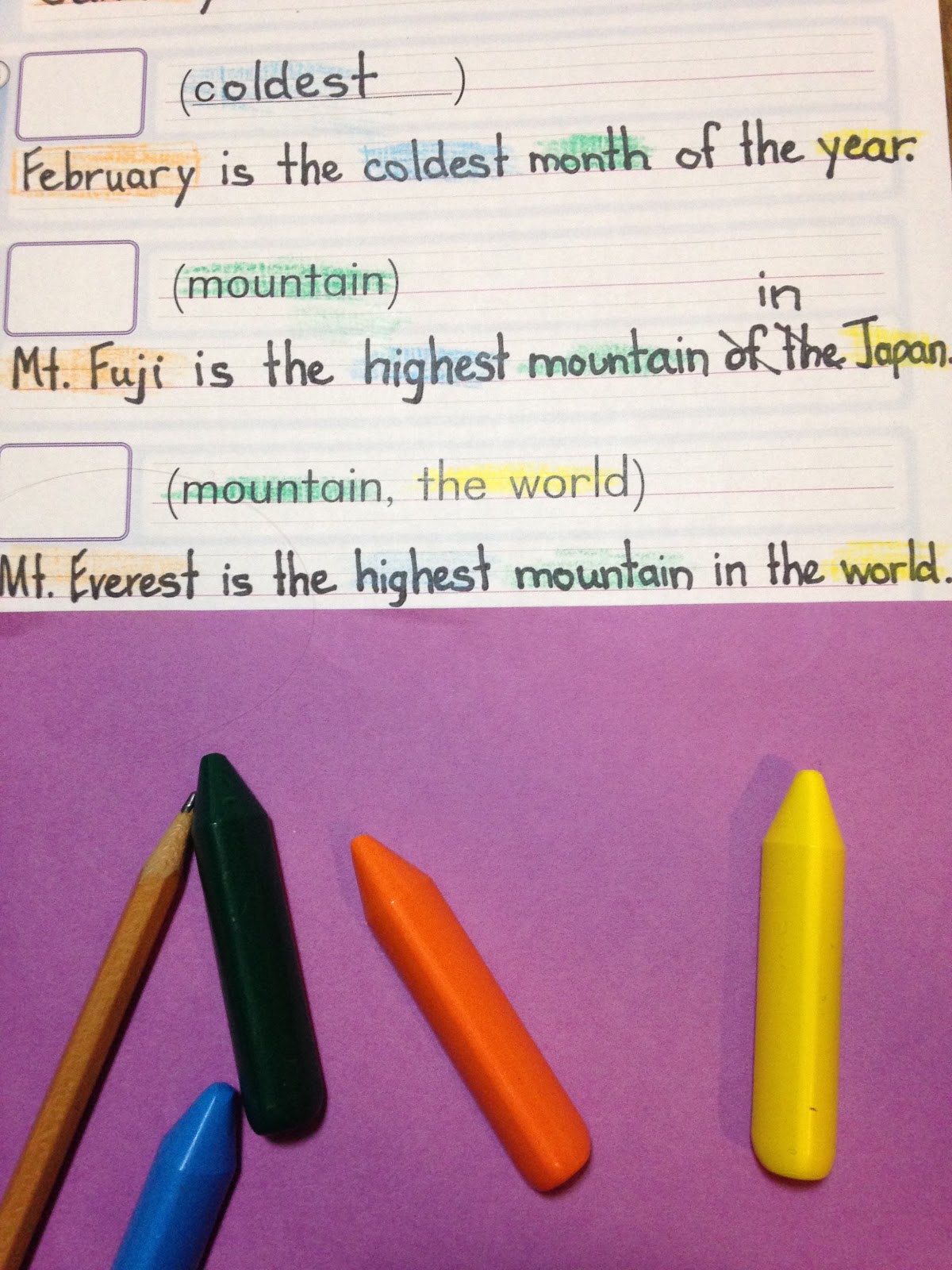
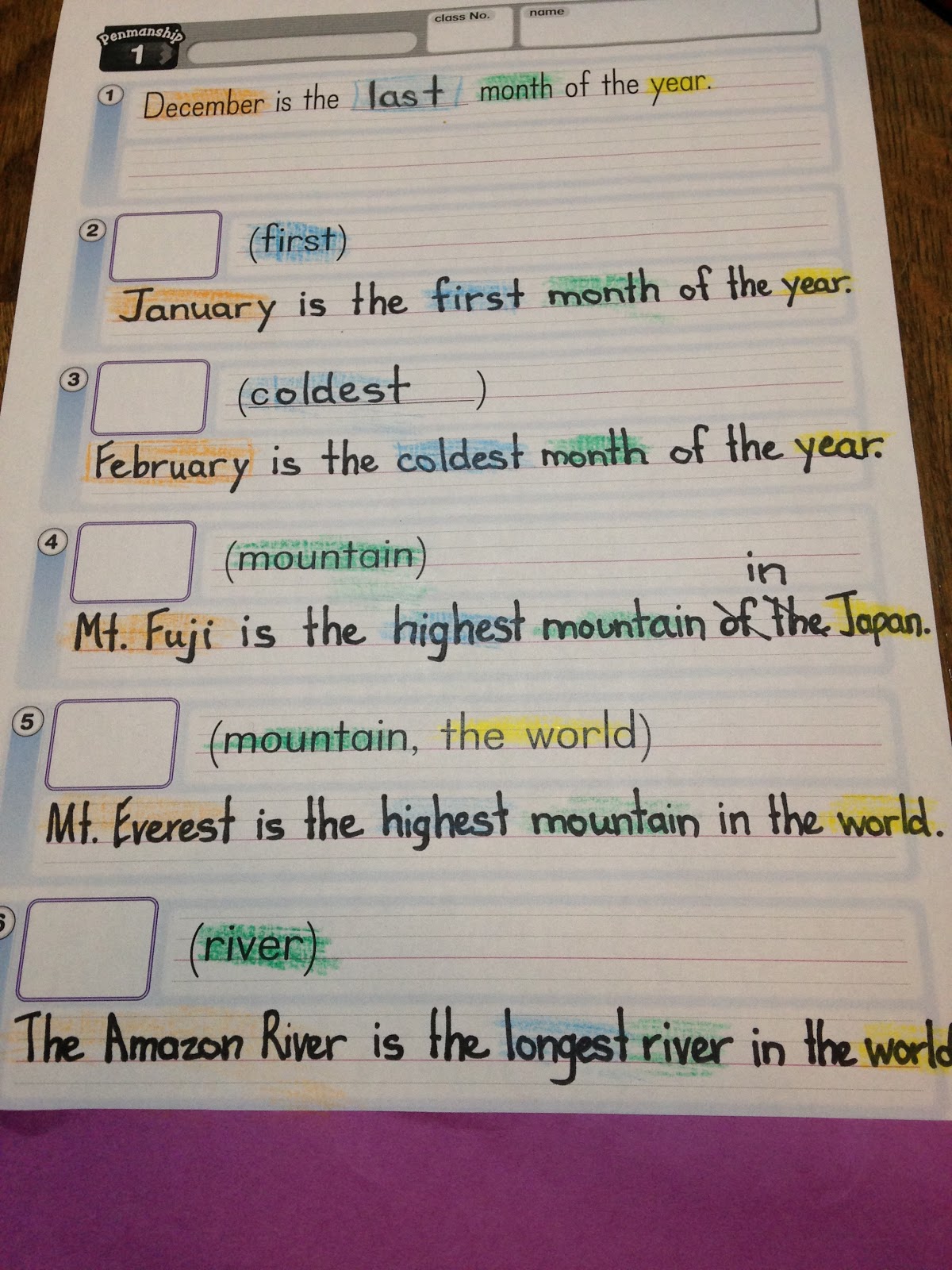
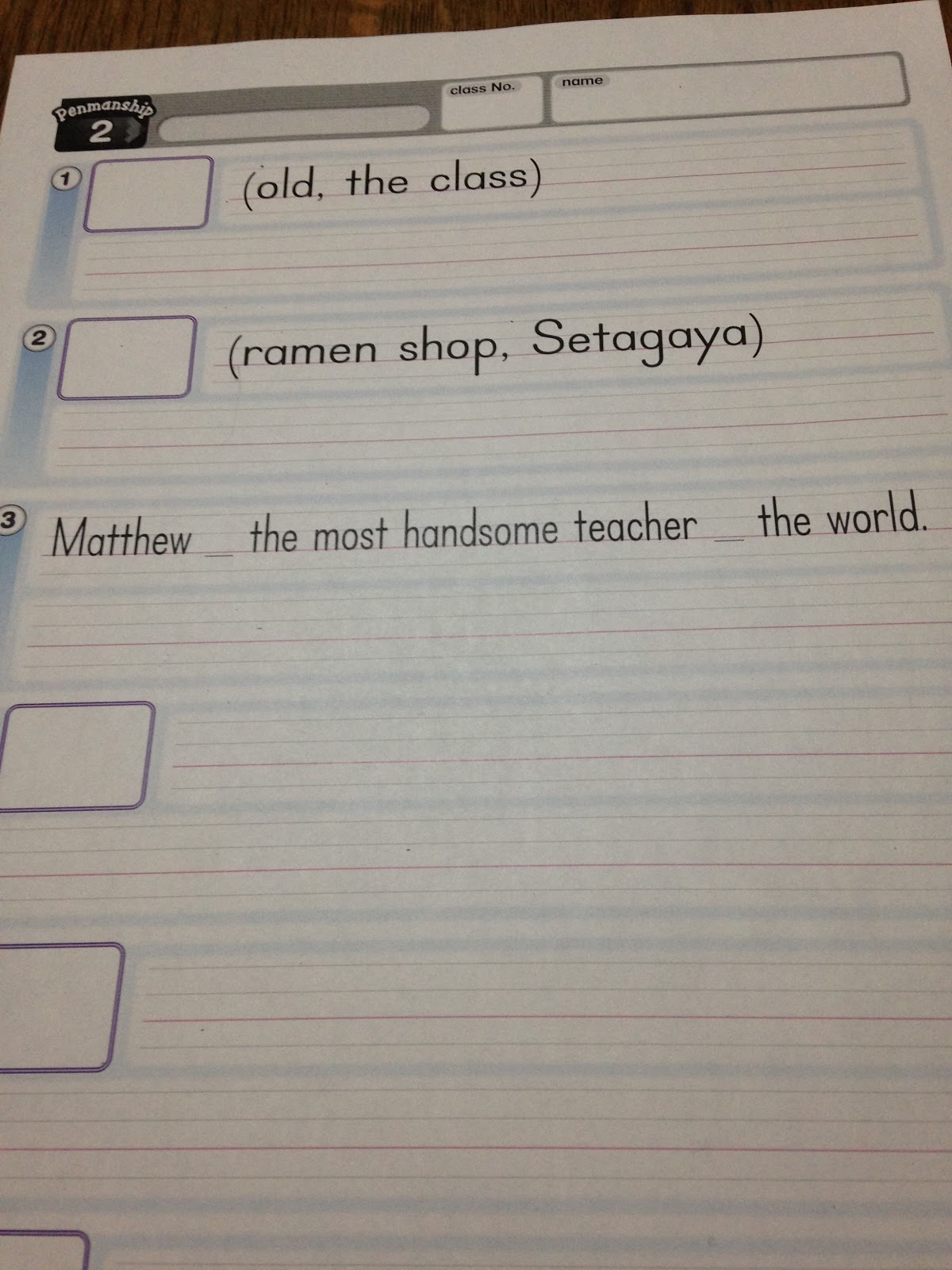
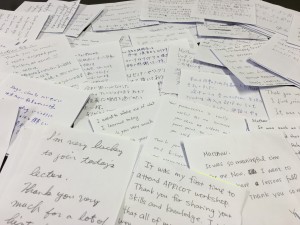
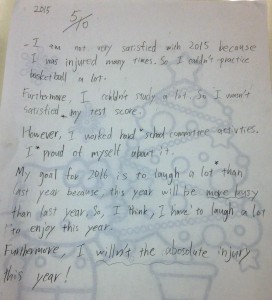
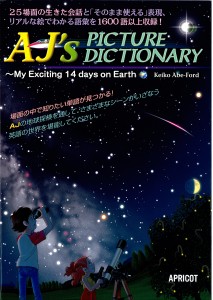
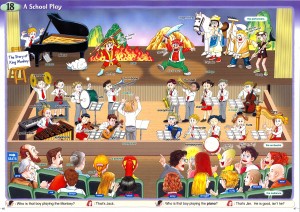
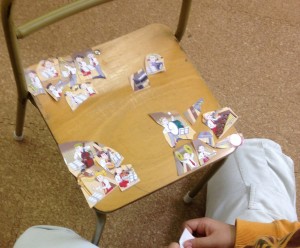 ←Click to enlarge
←Click to enlarge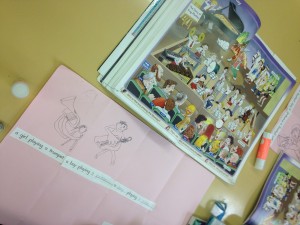 ←Click to enlarge
←Click to enlarge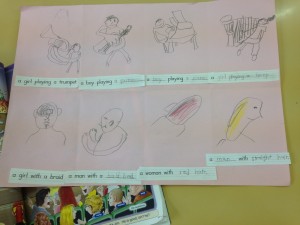 ←Click to enlarge
←Click to enlarge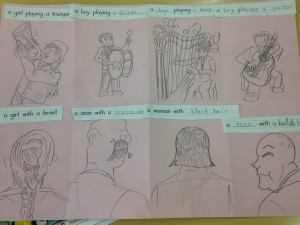 ←Click to enlarge
←Click to enlarge







